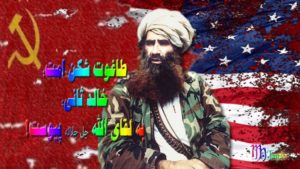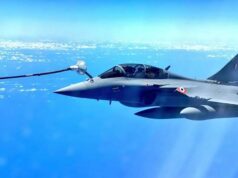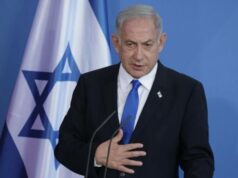
The Taliban disseminated this image of Jalaluddin Haqqani after announcing his death.
On September 4, the Taliban announced that Jalaluddin Haqqani had “passed away after a long battle with illness.”
A notorious jihadist who was one of Osama bin Laden’s earliest and closest allies, Haqqani had long been a recluse, with rumors swirling that he left the land of the living some years ago.
But if the Taliban is telling the truth, then Haqqani died only recently. The terrorist organization he built lives on, however, and it has more influence today than ever.
And a brief look at Haqqani’s career helps to explain how al Qaeda survived America’s relentless post-9/11 counterterrorism campaign.
After the September 11 attacks, some claimed that the hijackings were blowback—a consequence of America’s decision to work with Osama bin Laden and his men during the jihad against the Soviets in Afghanistan.
This “blame America” argument is still popular in the fever swamps online. But there is no publicly available evidence suggesting the CIA was ever in direct cahoots with bin Laden.
Haqqani is a different story, however, and a problematic one at that. The CIA, along with its Pakistani and Saudi allies, did back Haqqani and his followers against the Russians.
Congressman Charlie Wilson’s colorful life was first memorialized in a book and then a movie, with actor Tom Hanks playing the hard-partying politician from Texas.
Wilson famously pulled levers in Washington, with assistance from the CIA and others, to provide Haqqani and other “mujahedeen” with funding and weaponry during the war against the Soviets in the 1980s.
There is nothing in Wilson’s biography to suggest he was a religious zealot—quite the opposite. Yet he was smitten with Haqqani.
In Charlie Wilson’s War: The Extraordinary Story of How the Wildest Man in Congress and a Rogue CIA Agent Changed the History of Our Times, author George Crile writes that Wilson even described Haqqani as “goodness personified.”
Shoulder-fired missiles, or MANPADS (Man-Portable Air-Defense Systems), such as the Stinger, proved to be especially effective for downing Soviet helicopters.
Haqqani was among the mujahedeen commanders who received them. During a trip to Pakistan and Afghanistan, Wilson sought to fire one.
The story is briefly recounted in The Main Enemy: The Inside Story of the CIA’s Final Showdown with the KGB, by CIA veteran Milton Bearden, who worked the Afghan portfolio, and journalist James Risen. Haqqani’s men were happy to indulge Wilson’s wartime fantasy.
They used chains to rake the dirt on one road, hoping to kick up clouds of dust that would attract the attention of Soviet choppers.
The Red Bear was unmoved, however, and Wilson didn’t get his opportunity to down a Soviet warcraft. Still, the episode highlights how close Haqqani was to an American politician.
Haqqani and several other extremist commanders received the lion’s share of assistance from the American-Pakistani-Saudi coalition.
The CIA relied on Pakistani intelligence—the ISI—to pick winners and losers in the Afghan jihad, and this was a mistake. The Pakistanis preferred extremists.
“The CIA’s leadership continued to regard Pakistani intelligence as the jihad’s main implementing agency, even as more and more American trainers arrived in Pakistan to teach new weapons and techniques,” veteran journalist Steve Coll writes in his Pulitzer Prize-winning book, Ghost Wars: The Secret History of the CIA, Afghanistan, and bin Laden, from the Soviet Invasion to September 10, 2001.
“All this ensured that ISI’s Muslim Brotherhood-inspired clients… and radical commanders who operated along the Pakistan border,” including Haqqani, “won the greatest share of support.”
Coll, who interviewed American officials directly involved in the Afghan war effort, describes Haqqani as one of the “CIA’s favorites,” adding that he had the “CIA’s full support.
” Haqqani “ was seen by CIA officers in Islamabad and others as perhaps the most impressive Pashtun battlefield commander in the war,” a “proven commander who could put a lot of men under arms at short notice.” The CIA and Pakistani intelligence relied on Haqqani “for testing and experimentation with new weapons systems and tactics.”
He “was so favored with supplies that he was in a position to broker them and to help equip the Arab volunteers gathering in his region.”
The “Arab volunteers” included Osama bin Laden and the jihadists who founded al Qaeda in 1988. Haqqani gave them a foothold in South Asia.
His patronage was crucial for al Qaeda’s early development, as some of bin Laden’s most trusted lieutenants trained in Haqqani-sponsored camps and fought the Soviets alongside Haqqani’s men. It is a relationship that has survived more than three decades of war.
After the Soviets retreated from Afghanistan, the mujahedeen began fighting one another for power. Eventually the Taliban, backed by Pakistan, gained control of much of the country.
Haqqani joined the Taliban’s Islamic Emirate of Afghanistan, and he was named a member of the group’s shura, or senior advisory council. Haqqani was also named the minister in charge of the Afghan-Pakistan border.
Coll has written elsewhere that Haqqani was a “unilateral” asset of the CIA during the war against the Soviets.
So shortly after the 9/11 attacks, the agency made some furtive efforts to convince Haqqani to turn against the Taliban and al Qaeda.
The thinking was that the old alliance could be rekindled against a different foe. It didn’t work. Haqqani remained loyal to his Arab comrades, declaring jihad on the Americans.
In fact, according to Osama bin Laden’s own bodyguard, Haqqani sheltered the al Qaeda leader just weeks after the 9/11 attacks.
In Guarding bin Laden: My Life in Al-Qaeda, Nasser al-Bahri (also known as Abu Jandal) says that his master briefly “took shelter in Khost at his friend, Jalaluddin Haqqani’s house” before moving on.
Haqqani and his minions helped other al Qaeda operatives escape America’s retaliation in late 2001 as well.
Indeed, Haqqani had become a power-broker during the anti-Soviet jihad, in part because he controlled key terrain straddling the Afghan-Pakistan border.
Haqqani’s eponymous network has harbored al Qaeda operatives and leaders in this same region, which includes Waziristan, for years.
The United States has launched hundreds of drone strikes on the Haqqani strongholds in northern Pakistan.
It took nearly a decade for the United States finally to catch up with bin Laden. Files recovered during the May 2011 raid in Abbottabad, Pakistan, reveal that the Haqqani family remained closely allied with al Qaeda in the years following 9/11.
Jalaluddin Haqqani eventually relinquished his leadership role, passing authority to his son and ideological heir, Sirajuddin (or Siraj). Like his father, Siraj is an al Qaeda man.
In the spring of 2010, about a year before bin Laden’s death, the Haqqanis acted as intermediaries between the Afghan government and al Qaeda.
They helped negotiate a ransom payment, paid by the Afghans (in part with CIA-provided funds), to secure the release of an Afghan diplomat who was kidnapped in 2008. Millions of dollars in ransom flowed into al Qaeda’s coffers.
One memo to bin Laden described how the funds were divvied up, with some of the money being used to secure weaponry.
In another 2010 memo, bin Laden’s top lieutenant explained that al Qaeda used Siraj as a conduit for threatening the Pakistani state, warning that “big, earth-shaking operations” would take place if the Pakistanis didn’t negotiate a truce with al Qaeda.
At the time, al Qaeda was orchestrating a campaign of terror inside Pakistan that was intended to disrupt an American-led counterterrorism campaign.
That same memo, as well as other evidence, indicates that some Pakistani officials were willing to negotiate with al Qaeda to end the violence.
Bin Laden’s correspondence also described al Qaeda’s cooperation with Siraj in conducting anti-American attacks inside Afghanistan.
Today, Siraj is the deputy head of the Taliban’s Islamic Emirate of Afghanistan—a post that gives him broad power over thousands of insurgents fighting against the Afghan government, the United States, and their allies. Siraj has held that number-two position within the Taliban since 2015.
After Jalaluddin’s death was announced, al Qaeda honored the senior Haqqani as Osama bin Laden’s “brother.”
Al Qaeda also said in its eulogy that it took “solace” in the fact that Siraj had ascended through the Taliban’s ranks.
The United States is not responsible for the Haqqanis’ actions in the decades following the anti-Soviet jihad.
But Jalaluddin Haqqani’s life story should be a cautionary tale. Washington was willing to work with extremists to counter the Soviet threat.
That may have been somewhat justifiable during the Cold War, when communism was a nuclear-armed, worldwide threat.
But it was a deal with the devil—a man who was the opposite of “goodness personified.” And while the Soviet Union crumbled, the threat of global jihadism, which Haqqani incubated, lives on.
In September, the State Department released its annual Country Reports on Terrorism. Among its findings: Pakistan continues to provide safe haven for the Taliban’s leadership, including the Haqqanis.
The Trump administration has taken a hard line with Pakistan on this score. But there has been no change in Pakistan’s behavior.
As a result, the Haqqanis, along with their al Qaeda allies, are poised to declare victory in Afghanistan once again.
Thomas Joscelyn is a Senior Fellow at the Foundation for Defense of Democracies and the Senior Editor for FDD’s Long War Journal.



